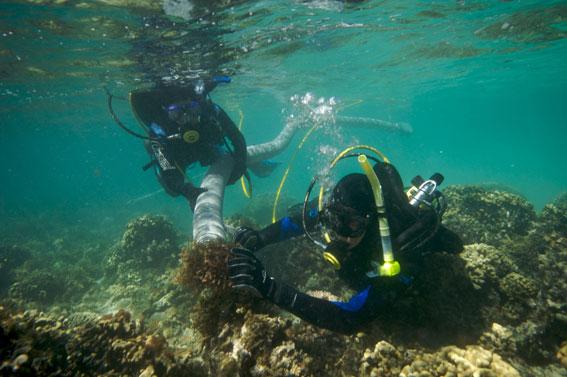 [Image: The Super Sucker in action].
[Image: The Super Sucker in action].
A vacuum has been developed that can suck invasive seaweed off of coral reefs. The machine is called the Super Sucker:
To create the Super Sucker, biologists modified a system designed for gold dredging. Seaweed from reefs is sucked up and dumped onto mesh sorting tables on a barge. Native organisms inadvertently vacuumed are removed and returned to the reef and the seaweed is eventually used by farmers as fertiliser.
Now we just need a job board where you can apply for the position of Reef Sucker: you fly around the world vacuuming weeds off reefs. You drink a lot of coffee and get up at 5am, and you dream of moray eels.
So will they develop a special, dry land version of this thing for cleaning the ornaments of Gothic cathedrals? A huge vacuum chamber beneath the streets of Rome that you can tap into with hoses in order to suck all the dust from the city.
Or perhaps a special type of handheld saw, or modified sander, will be made to go along with the Sucker – the Sander and the Sucker – so you can sculpt coral reefs through precise cuts and abrasions. The Great Barrier Reef becomes rather Bauhaus in appearance. And the reefs of south Florida – well, those now look like something from the Amsterdam School. South Pacific atolls are carved into rings of underwater statuary.
So much for the natural.
The world is more interesting when it’s all been Sucked & Sawed™.
Geoff, thank you for providing some much needed humor relief with the hilarious caption.
After reading this post and working on my own, a picture popped into my head of divers wielding giant electric toothbrushes on Great Whites to clean off the residue of fates similar to Quinn at the end of Jaws.
Seriously, why can’t nature be nature and artifice be artifice? With thoughtful design, it seems each can complement the other.
The Super Sucker is not actually for aesthetic reasons, on the other hand – I just made it sound that way. Sorry for the confusion! See this article in The New York Times, for instance.
And I agree with you that nature and artifice can complement one another quite well, in the context of thoughtful design opportunities, but I also think that crossing the lines between them is an oddly invigorating thing to do. An earlier post here picks up some of these themes, discussing zoo design.